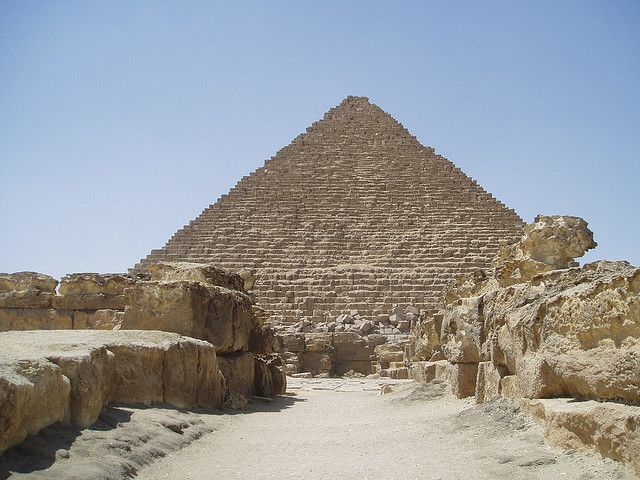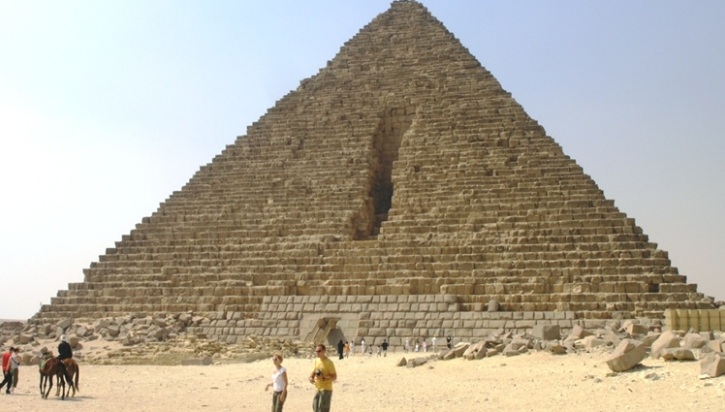Introduction: The Smallest of the Great, Yet Rich in Mystery
Nestled beside its towering neighbors on the Giza Plateau, the Mycerinus Pyramid Egypt—also known as the Pyramid of Menkaure—may be the smallest of the three iconic pyramids of Giza, but it holds a charm and intrigue all its own. Often overshadowed by the grandeur of the Great Pyramid of Khufu and the Pyramid of Khafre, Mycerinus stands out not for its size but for its elegance, precision, and the mysteries it still keeps hidden beneath its ancient stones.
If you're planning a trip to Egypt, especially if you're fascinated by ancient wonders that go beyond the typical tourist photos, then visiting the Mycerinus Pyramid Egypt is an experience you should not miss. With fewer crowds, rich historical context, and breathtaking surroundings, this pyramid provides a serene window into ancient royal power and architectural mastery.

Who Was Mycerinus (Menkaure)?
Mycerinus, also known by his Greek name Menkaure, was a pharaoh of Egypt's Fourth Dynasty during the Old Kingdom period, ruling around 2530 BC. He was the son of King Khafre (builder of the second Giza pyramid) and grandson of King Khufu (builder of the Great Pyramid).
Unlike his predecessors, who built enormous structures and were known for their strong-handed rule, Mycerinus had a reputation for being a just and benevolent king. Herodotus, the ancient Greek historian, even praised Mycerinus for reversing the harsh policies of his father. This legacy of wisdom and fairness adds a special dimension to his pyramid—it’s not just a monument, but a tribute to a ruler remembered for kindness and justice.
Architectural Features of the Mycerinus Pyramid Egypt
Although the Mycerinus Pyramid Egypt is the smallest among the Giza trio, standing at about 65 meters (213 feet) originally, it is also the most refined. Its compact size makes it more accessible to visitors, and its construction offers fascinating details that are often missed at the larger pyramids.
✨ Highlights:
-
Granite Casing: Unlike the limestone casing on Khufu’s and Khafre’s pyramids, the lower courses of Mycerinus’s pyramid were made of finely polished red granite from Aswan. This choice reflected both strength and elegance.
-
Three Queen's Pyramids: Adjacent to the main pyramid are three smaller pyramids believed to belong to queens or consorts. Two of these were finished, while one remains incomplete—offering insight into construction techniques.
-
Interior Design: Inside the pyramid are chambers cut from the bedrock and corridors lined with granite, leading to a burial chamber. Although the king’s sarcophagus was lost in the 19th century during transport, the internal complexity still attracts archaeology lovers.
-
Smooth Slope: The Mycerinus Pyramid features a slightly steeper angle than Khafre's, resulting in a unique, elegant profile.
.jpg)
Why Visit the Mycerinus Pyramid Egypt?
While many tourists flock to the larger pyramids and the nearby Sphinx, the Mycerinus Pyramid offers a quieter, more personal experience—ideal for travelers looking to connect deeply with the past.
Top Reasons to Visit:
-
Unmatched Serenity: With fewer visitors, it’s easier to explore, reflect, and photograph without crowds.
-
Historical Significance: Learn about a pharaoh celebrated for compassion, not just conquest.
-
Architectural Beauty: Examine the craftsmanship of granite casing and underground tombs.
-
Perfect Photo Spot: Stunning views with a less obstructed backdrop make for beautiful photography.
-
Sunset Splendor: Its location provides stunning desert sunset views over the Giza Plateau.
The Queen’s Pyramids: An Added Layer of Discovery
The three satellite pyramids next to Mycerinus’s main structure are worth exploring in their own right. Two are fully constructed with descending passages, while one remains incomplete. These pyramids suggest the prominence of royal women in the pharaoh's life and in burial traditions of the Fourth Dynasty. Their proximity offers insight into ancient family structures and funeral customs.
Tips for Visiting Mycerinus Pyramid Egypt
To get the most out of your visit, here are a few practical and cultural tips:
-
Visit Early: The best lighting for photography and cooler temperatures happen before 10:00 AM.
-
Dress for the Desert: Comfortable shoes, sunglasses, and a hat are essential. Sunscreen is a must.
-
Hydrate Well: Always bring bottled water—Cairo’s sun can be intense even in winter.
-
Go Inside (if open): Interior access is sometimes allowed, depending on restoration work.
-
Hire a Local Guide: Gain rich historical insights and avoid missing important architectural details.
Suggested Itinerary: Half-Day Pyramid Tour
Morning:
-
Start your adventure at the Great Pyramid of Khufu, then move on to the Pyramid of Khafre.
-
End the trio with a peaceful and rewarding visit to the Mycerinus Pyramid Egypt.
Midday:
-
Enjoy lunch at a nearby Giza café or local restaurant.
Afternoon:
-
Visit the Solar Boat Museum (if open) or head to Sphinx Square for a panoramic view of the entire Giza Plateau.
Nearby Attractions to Combine With Your Visit
-
The Great Pyramid of Giza (Khufu): The largest pyramid in Egypt and one of the Seven Wonders of the Ancient World.
-
Khafre’s Pyramid: Known for its partially intact capstone and connection to the Great Sphinx.
-
The Sphinx: The mysterious guardian of the pyramids, carved from a single limestone block.
-
Grand Egyptian Museum (Opening Soon): Set to house thousands of ancient treasures.
-
Memphis and Saqqara: Just a short drive south, these sites offer the chance to see older pyramids, including the famous Step Pyramid of Djoser.
Unsolved Mysteries of Mycerinus
Despite decades of excavation and study, several questions remain unanswered:
-
Why was the lower part of the pyramid covered in red granite while the upper portion remained incomplete?
-
Who were the queens buried beside him, and what roles did they play?
-
Why did Herodotus associate Mycerinus with a legend of tragedy and divine judgment?
These mysteries continue to intrigue historians and visitors alike, adding layers of fascination to the visit.
What Sets Mycerinus Apart?
Unlike the overpowering scale of Khufu’s pyramid or the imposing bulk of Khafre’s, the Mycerinus Pyramid Egypt invites you into a more intimate relationship with Egypt’s ancient past. It reflects a different kind of legacy—a ruler remembered not just for his monuments but for his humanity.
This pyramid is a symbol of quiet dignity and royal respect. It reminds us that greatness is not always measured by size but by the stories we leave behind.
Conclusion: A Serene Jewel of the Giza Plateau
If you're planning your Egyptian itinerary and wondering which pyramid will leave a lasting impression, don't overlook the Mycerinus Pyramid Egypt. Smaller in scale but grand in meaning, it offers a unique and deeply personal glimpse into Egypt’s royal heritage. Wander through the silent corridors, feel the warm granite under your hands, and imagine the ancient rituals once performed in its sacred chambers.
Explore beyond the obvious. Discover the legacy of Pharaoh Mycerinus.

